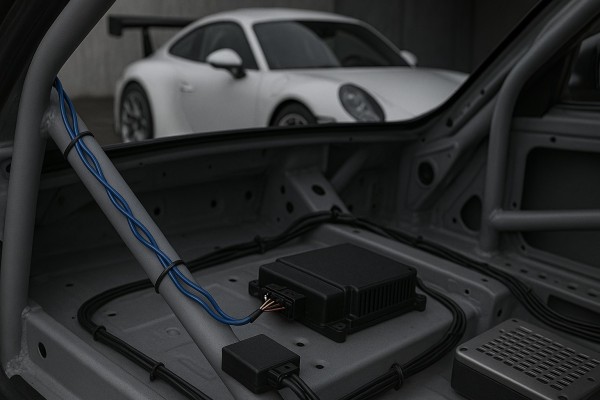Racing telemetry
How to Accurately Obtain Telemetric Data for Your Racing Vehicle
by Paweł Sobociński |

In the high-octane world of motorsports, every second matters. Whether you're a professional racer or an amateur enthusiast, having access to accurate telemetric data can give you a critical edge. Telemetry refers to the real-time collection and transmission of data from a vehicle to a central system, allowing teams and drivers to monitor performance, analyze driving habits, and make data-driven decisions. In this article, we’ll break down the key steps involved in obtaining telemetric data and how you can use it to enhance your racing vehicle’s performance.
What is Telemetric Data?

Telemetric data encompasses a variety of parameters, including speed, acceleration, tire pressure, engine temperature, brake performance, throttle position, and more. These data points are collected by sensors installed in your racing vehicle, which continuously monitor performance throughout a race or practice session. The primary purpose of telemetric systems is to provide actionable insights into a vehicle’s performance, allowing racers to make real-time adjustments to improve speed, handling, and overall performance.
Why Telemetric Data Matters in Motorsports?
Telemetric data plays a critical role in identifying areas for improvement and ensuring optimal vehicle performance. Key reasons why telemetric data is essential in motorsports include:
- Improved Performance and Efficiency: Telemetric data gives real-time feedback on vehicle performance. By tracking tire temperature, brake pressure, and engine performance, racers can make key adjustments to improve lap times and consistency.
- Strategic Decision-Making: Teams can use telemetric data to identify areas where the vehicle is underperforming. Whether it’s optimizing gear ratios, adjusting suspension settings, or fine-tuning aerodynamics, telemetric data helps drivers and engineers make data-backed decisions to enhance performance.
- Predictive Analysis: With telemetric data, teams can analyze trends, predict failures, and optimize setups before race day. This leads to better-prepared vehicles, reduced downtime, and increased reliability.
Steps to Accurately Obtain Telemetric Data

Accurate telemetric data collection is crucial for ensuring optimal vehicle performance and reliability. Below are the key steps to achieve this effectively.
1. Select the Right Telemetric System
The first step to obtaining accurate telemetric data is selecting the right system. Telemetric systems vary based on the type of racing vehicle, the complexity of the data you need, and the budget available.
Standalone Systems vs. Integrated Systems:
- Standalone Systems: These are self-contained systems that typically come with sensors and data loggers. They’re suitable for racers who want flexibility and customization.
- Integrated Systems: Many professional racing teams opt for integrated telemetric systems, which are often built into vehicles’ existing electronics. These systems offer more seamless integration with the vehicle’s control systems.
Key Components of a Telemetric System:
Data Logger: The data logger captures all the incoming signals from the sensors and stores the data.
Sensors: Sensors are installed on various parts of the vehicle to collect performance data. Common sensors measure things like speed, acceleration, RPM (revolutions per minute), tire pressure, brake pressure, etc.
Telemetry Transmitter: The transmitter sends the collected data wirelessly to a central system for processing and analysis.
2. Install Sensors on Key Vehicle Components
To collect comprehensive telemetric data, sensors need to be installed on critical parts of the vehicle. Here are the primary areas where sensors are typically placed:
Tires and Suspension Components:
- Tire Pressure Sensors:
- Monitor tire pressure and temperature, crucial for maintaining optimal grip and preventing overheating.
- Suspension Sensors: Track suspension travel and performance, helping identify understeer or oversteer conditions.
- Braking System:
- Brake Pressure Sensors: Monitor brake pressure and temperature, enabling adjustments to brake bias and pad selection.
- Engine Performance:
- RPM Sensors: Measure engine RPM to assess performance and optimize gear ratios.
- Throttle Position Sensors: Provide data on throttle control, helping with power delivery and fuel efficiency.
- Vehicle Dynamics Sensors:
- Accelerometers: Measure lateral and longitudinal acceleration, helping identify areas of acceleration or deceleration where performance may be compromised.
- Gyroscopes: Track vehicle orientation and pitch, crucial for stability and aerodynamic performance analysis.
3. Collect and Analyze Data During Practice Sessions
Once the sensors are installed, the next step is to collect data during practice or test sessions. Here’s how to ensure you’re collecting accurate and valuable information:
- Real-Time Monitoring: Telemetric systems stream live data, letting drivers and engineers monitor performance and make quick adjustments during practice.
- Data Logging: Loggers store telemetry data. Ensure yours has enough storage for long sessions or races.
- Sampling Frequency: Higher sampling rates give more detailed data but need more processing power and storage.
- Post-Session Analysis: Use software to analyze data and generate visualizations like graphs and heatmaps. Look for patterns in tire wear, engine performance, or braking inconsistencies.
4. Interpret Data and Make Adjustments
Data alone won’t improve performance—it’s how you interpret and act on it that matters. Here are some key areas to focus on when analyzing telemetric data:
1.Tire Performance - Monitoring tire pressures, temperatures, and wear patterns is critical for optimizing performance and efficiency on the track. Properly adjusted tire pressures can improve grip and durability, while analyzing temperature and wear patterns helps avoid premature tire failures. These insights allow teams to make informed decisions about tire choices and setups, ensuring peak performance throughout a race.
2. Braking Points - Braking performance plays a crucial role in lap time consistency and overall vehicle control. Telemetry data on brake pressure and temperature allows teams to fine-tune brake bias and ensure the system performs reliably throughout a race. Monitoring these metrics also prevents overheating, which can lead to fading brakes or failure. Adjusting braking points based on data helps drivers maintain control during corner entries, maximizing speed and reducing wear on the system for optimal race outcomes.
3. Engine Optimization - Refining engine performance is essential for maximizing speed and reliability. Analyzing engine RPM and throttle position helps teams adjust gear ratios, fuel mapping, and power delivery. Optimized gear ratios improve acceleration and top speed, while efficient fuel mapping enhances fuel economy and power balance. This ensures the engine operates at peak performance, reducing wear and improving race results.
4. Vehicle Dynamics - Understanding vehicle dynamics is key to achieving optimal handling and stability. Telemetry data from accelerometers and gyroscopes helps engineers detect balance issues, such as understeer or oversteer. By addressing these problems, teams can enhance vehicle stability and improve cornering performance. Adjustments to suspension and weight distribution are often made based on this information, ensuring the car remains predictable and responsive under varying track conditions.
5. Setup Adjustments - Telemetry data is a goldmine for optimizing a car’s setup to meet the unique demands of different tracks. Suspension stiffness, aerodynamic balance, and other critical components can be fine-tuned using this data. Adjustments based on track conditions, such as weather or surface grip, ensure the car performs consistently across sessions. These refinements not only improve lap times but also enhance reliability over a race’s duration.
5. Integrate with Data Analysis Tools
To get the most out of telemetric data, consider integrating with advanced data analysis tools and platforms designed to enhance performance and decision-making. Tools like MATLAB, Motec, or Pi Dashboard provide a range of features, including detailed insights, simulations, and data comparisons.
These platforms allow teams to visualize data trends in real-time, identify patterns, and gain a deeper understanding of system performance. By leveraging these tools, teams can make more educated, data-driven decisions, optimize operations, and even predict potential issues before they arise, ultimately improving efficiency and outcomes.
Conclusion
Accurately obtaining telemetric data for your racing vehicle is essential for improving performance and gaining a competitive edge in motorsports. By selecting the right telemetric system, installing key sensors, collecting and analyzing data, and making data-driven adjustments, racers can optimize their setups, improve lap times, and enhance overall performance. Whether you’re a professional team or an amateur enthusiast, investing in a reliable telemetric system is a crucial step toward mastering the complexities of motorsport.




